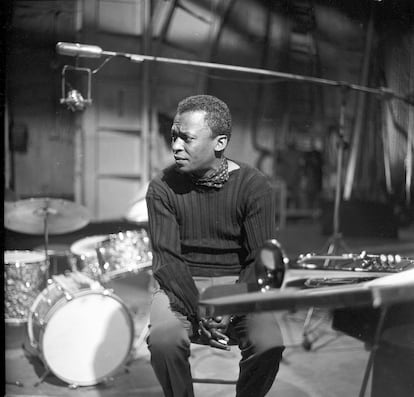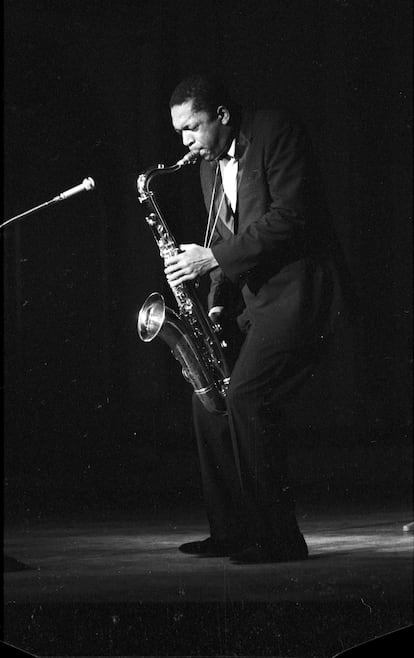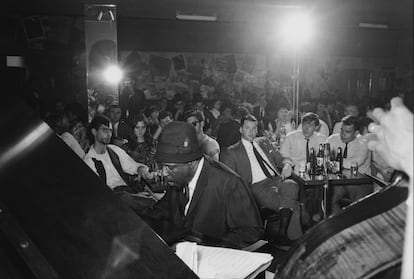1959: The glorious year of jazz
The emergence, 65 years ago, of a generation of ambitious musicians and best-sellers gave new life to a genre that was losing the talent of Billie Holiday and Lester Young


The latest issue of Jazz Magazine has a striking cover. In the center, a date: 1959. And a subtitle: “Journey to the heart of the best year in the history of jazz.” It is true that this exaltation is not new, in fact it is very much a nostalgic topic, but the French magazine delves into the great stars of that prodigious year. Miles Davis stands out as its main figure: his Kind of Blue is widely considered the best-selling jazz album of all time (although we should be wary of these boasts by record labels that are not backed up by figures).
There was a lot of the miraculous about Kind of Blue: it was recorded in 10 hours, spread over two days in March and April, without prior rehearsals and with minimal instructions from the trumpet player. Miles’s personal magnetism managed to create a serene, impeccably cool atmosphere; even the title seems as colloquial as it is enigmatic, an anticipated answer to those questions about his albums that Miles detested so much. Jazz Magazine highlights the age of the participants, almost all of them in their thirties. That is, with exciting memories of the bebop insurrection, but also aware of its risks—Charlie Parker had died in 1955—and willing to try modal jazz. It was a true dream team: saxophonists John Coltrane (tenor) and Julian Cannonball Adderley (alto), pianists Bill Evans and Wynton Kelly, double bassist Paul Chambers and drummer Jimmy Cobb.
All of them would grow musically in 1959. Miles himself would insist on adapting the second movement of Joaquín Rodrigo’s Concierto de Aranjuez, an audacity that would deeply irritate the Spanish composer but that would lead to another groundbreaking album the following year, Sketches of Spain. Coltrane, who had already recorded a lot, both as a leader and as a sideman, at Rudy Van Gelder’s studio in New Jersey, signed a deal with New York’s Atlantic Records in exchange for a Lincoln Continental sedan and a guaranteed pay of $7,000 a year (today it would be about $75,000). He wanted a minimum of security: in Giant Steps he would drop the standards to play his own songs with superhuman concentration. Coltrane would participate in Cannonball Adderley Quintet in Chicago, contrasting his busy sound with Cannonball’s more earthly expression.

The pianist Bill Evans was shyer than his peers. Despite having provided the germ of two of the pieces on Kind of Blue, for his first album in 1959, Everybody Digs Bill Evans, he focused on other pieces, although his delicate solo theme, Peace Piece, has had numerous subsequent recreations, even in the classical universe. Miles’ respect for Evans was such that he did not grumble when he played on Chet, a New York album by his Californian competitor, Chet Baker.
If Bill Evans was reticent about his talent, there was another pianist happy to find the perfect jazz trio: the Canadian Oscar Peterson recorded more than a dozen sparkling LPs in 1959, from A Jazz Portrait of Frank Sinatra to Oscar Peterson Plays Porgy & Bess. Some may wonder if so much production was profitable. Well, yes: these were quick (= cheap) recordings and, although it was not known at the time, that they would have a long commercial life. In addition, record labels needed to diversify their offering. Rock and roll had lost momentum, with Elvis Presley serving his military service in Germany and Buddy Holly dying in a plane crash (a year later, in 1960, another equally talented singer-guitarist, Eddie Cochran, would be killed).
Devastated lives
The world of jazz would also experience devastating losses in 1959, generally due to alcohol or hard drugs. The sublime saxophonist Lester Young died after a European tour, at the age of 49. At his funeral, his friend Billie Holiday remarked that she would be next and, indeed, she died four months later, at the age of 44. Near Paris, Sidney Bechet, a link to the murky origins of New Orleans jazz, passed away. And Boris Vian, novelist, singer and formidable jazz publicist in France, also died at the age of 39.
The life of the jazzman or jazzwoman could be rough. Thelonious Monk, a pianist and composer with a fragile mind, had unpleasant encounters with the police that led to the revocation for years of his cabaret card, essential to play in New York clubs. To vindicate his angular talent, he was presented in February 1959 on a university campus with an extensive lineup, an evening from which produced The Thelonious Monk Orchestra at Town Hall. Charles Mingus was another problematic genius. Fresh out of the Bellevue psychiatric hospital in Manhattan, he formed an all-star group—on saxophones, no less than Booker Ervin and John Handy—that recorded for Atlantic and Columbia. The second company released Mingus Ah Um, which combined a vigorous carnality with sober nods to their predecessors: Ellington (Open letter to Duke), Lester Young (Goodbye Pork -pie Hat) and Jelly Roll Morton (Jelly Roll). Equally notable is Fables of Faubus, a mockery of Orval E. Faubus, the racist governor of Arkansas who opposed the integration of white and black students, forcing President Eisenhower to come out of his lethargy and send federal troops: the famous First Airborne Division. Mingus, however, had Columbia veto the lyrics, and the label instead published an instrumental version.

The involvement of jazz in the fight for civil rights was immediate and had abundant manifestations; in 1960, the powerful We Insist!, also known as the Freedom Now Suite, was released, the work of drummer Max Roach, his partner Abbey Lincoln and lyricist Oscar Brown. It was received coldly, perhaps because of its wide thematic range—from southern slavery to South African apartheid—or maybe because of its musical intensity. In 1959, Ornette Coleman had tested the tolerance of the jazz public, including his own colleagues, with an album provocatively titled The Shape of Jazz to Come. The shape of jazz of the future involved unpredictable improvisations and a strident sound, partly derived from the use of a plastic saxophone.
It heralded the coming materialization of the free jazz movement, a kick in the shin to formalists like Dave Brubeck, whose ingenious Take Five would sell millions of copies in later years. It also represented a rejection of hard bop, especially in the soul jazz (Jimmy Smith!) or funky variety, embodied in 1959 by Horace Silver, a pianist with roots in the Cape Verde Islands (Ornette’s astringent approach dispensed with the piano). They said that Silver’s compositions brought tropical exoticism to jazz, but they ignored that that same year two contagious albums were released in Brazil: the soundtrack of Orfeo Negro and the first album by João Gilberto. Bossa nova emerged, which, starting in 1962, would flood jazz like a tsunami.
Sign up for our weekly newsletter to get more English-language news coverage from EL PAÍS USA Edition
Tu suscripción se está usando en otro dispositivo
¿Quieres añadir otro usuario a tu suscripción?
Si continúas leyendo en este dispositivo, no se podrá leer en el otro.
FlechaTu suscripción se está usando en otro dispositivo y solo puedes acceder a EL PAÍS desde un dispositivo a la vez.
Si quieres compartir tu cuenta, cambia tu suscripción a la modalidad Premium, así podrás añadir otro usuario. Cada uno accederá con su propia cuenta de email, lo que os permitirá personalizar vuestra experiencia en EL PAÍS.
¿Tienes una suscripción de empresa? Accede aquí para contratar más cuentas.
En el caso de no saber quién está usando tu cuenta, te recomendamos cambiar tu contraseña aquí.
Si decides continuar compartiendo tu cuenta, este mensaje se mostrará en tu dispositivo y en el de la otra persona que está usando tu cuenta de forma indefinida, afectando a tu experiencia de lectura. Puedes consultar aquí los términos y condiciones de la suscripción digital.
More information

The “jazz detective” who finds lost music treasures
Archived In
Últimas noticias
Most viewed
- Reinhard Genzel, Nobel laureate in physics: ‘One-minute videos will never give you the truth’
- Oona Chaplin: ‘I told James Cameron that I was living in a treehouse and starting a permaculture project with a friend’
- Pablo Escobar’s hippos: A serious environmental problem, 40 years on
- Why we lost the habit of sleeping in two segments and how that changed our sense of time
- Charles Dubouloz, mountaineering star, retires at 36 with a farewell tour inspired by Walter Bonatti








































